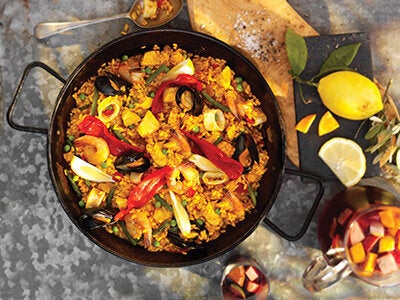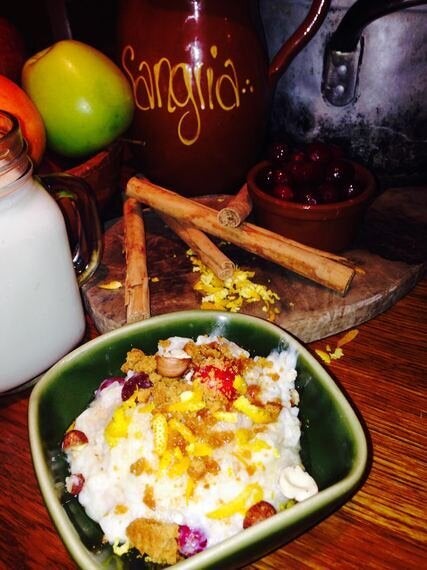There is nothing the Spanish love more than the three Fs: family, fiestas and, most importantly, food! So much so in fact, that there is a day dedicated to the classic Paella! 27 March is National Paella Day and celebrates the traditional Spanish dish in all its glory.
To mark the celebrations, I wanted to share with you two of my personal favourite Paella recipes: a simple classic Paella with chicken and seafood and a twist on the on the old favourite, a sweet and fruity paella for those who are feeling a little more adventurous!
Paella with chicken and seafood:

This is a classic Spanish paella, which a lot of people are nervous about cooking. It really doesn't have to be difficult though! Just follow these simple steps and you'll have the perfect paella! It takes around 45 minutes, depending on how long you want to rest it for, and serves three to four people.
Ingredients:
200g of Spanish paella rice such as bomba or calasparra
2 tbsp olive oil
1 tsp paprika
1g of saffron (or turmeric if you don't have saffron)
675ml good quality fish stock (475ml if using calasparra rice)
4 small ripe tomatoes
2 medium sized shallots/onions, finely chopped
1 small bell pepper, seeded and diced into 2-3cm chunks
2 medium sized fresh chicken breasts, diced into 2-3cm chunks
200g prepared medium-sized squid, cut into 2cm thick rings
4 large raw peeled prawns with the tails on
6 fresh large mussels, cleaned
40g fine green beans, top, tailed and chopped into 2cm
30g garden peas
Pinch of salt & pepper
1 roasted sweet red pepper, cut into quarters to garnish
1 lemon cut into wedges
Crockery/kitchenware
1 paella pan or a 30cm large heavy bottom frying pan
1 small saucepan
Method
- Score a small cross on the base of each tomato, then carefully place into a pan with boiling water, leave for 20 to 30 seconds, then remove using a slotted spoon. Drop the tomatoes into a bowl of ice cold water and leave to cool. Remove the tomatoes then peel away the skin. Cut the tomatoes into quarters, and then roughly chop the flesh. Set the chopped tomato aside.
- Place the Paella pan over a medium-high heat and pour in most of the garlic infused olive oil. When hot add the shallots and cook for 3-4 minutes until softened and sweet.
- Stir in the peppers and cook for 2 -3 minutes until they become slightly soft then move to the side of the pan. Add the remaining garlic olive oil then the chicken and cook for 2-3 minutes until it starts to brown.
- Stir in the prawns and squid, cook for 3-4 minutes until the squid is white and opaque in colour. Mix all together.
- Add the diced tomatoes, mussels, almost all of the fish stock (leave 50 to 75ml back), pimentón and the saffron. Mix in the green beans and peas, once the broth is at a rolling boil and the chicken and seafood are cooked through, taste the broth to make sure you are happy with the flavour (at this point you are looking for a strong flavour of Smokey paprika, fragrant saffron and a fish stock kick) - season with salt and pepper if required.
- Add the Paella rice, making a cross in the pan with the rice from one side to the other.
- Share the rice around the pan carefully using a spoon stirring briefly or 'tickle' the rise to evenly distribute it into the four sections making sure the rice is even throughout the pan and continue to cook for 5 minutes. Turn the pan around and arrange the mussels in the pan, push them down slightly. From now on remember this rule...move the pan, do not stir the paella.
- If you are cooking the traditional way on a gas stove, reduce the heat to medium and place the roasted red pepper quarters on top of the paella - let it cook for 15 minutes, moving the pan around from time to time until the broth has been totally absorbed by the rice. If you are cooking on an electric hob I recommend you transfer the paella to a pre-heated oven set at 180c for the final 10 minutes of cooking. (I always suggest this cooking method because I find that most electric hobs are just not big enough to spread the heat evenly across the bottom of a 30cm pan)
- Have the remaining fish stock on hand to gently ladle over the rice if required at any point within the final 5-10 minutes of cooking.
- Once the broth has totally disappeared, check that the rice is al dente - cooked but with a slight bite, then turn off the heat or remove from the oven and let it rest!
A rest is so important: 15 minutes is my golden rule, however if you have the luxury of waiting up to 45 minutes you will see a notable difference in texture and condensed taste. If you choose the 45-minute wait, make sure you cover the pan loosely with a clean kitchen towel or kitchen foil.
Great paella should have a layer of rice caramelised on the bottom of the pan together with looking compact and caramelised on top; add the lemons just before serving! Only fluff up the Paella when you are about to serve! And I like to enjoy mine with a cold glass of Sangria! Perfecto!
Arroz Con Leche (Seville)

This recipe is great for those who are feeling more adventurous and fancy more of a sweet treat. It's definitely a twist on the classic, but if you've got a bit of a sweet tooth then this is the one for you! It takes around an hour to prepare and cook and serves three to four people.
Ingredients
250g of Spanish paella rice such as bomba or calasparra
1 big cinnamon stick
Zest from 1 orange
1 litre of water
1 free-range egg, beaten
1 Madagascan vanilla pod (split and deseeded)
500ml semi skimmed milk
1 red apple, grated
1 small can of condensed milk
50g frozen or fresh cranberries
1 tbsp. Demerara sugar
40g roasted and chopped hazelnuts
3-4 ginger nut biscuits
2 fresh figs (optional)
Crockery/kitchenware
1 large heavy bottom saucepan
1 bowl
1 whisk
Method
- Soak the rice, cinnamon stick and half of the orange zest in water directly in the saucepan you intend to cook the pudding in.
- After 30 minutes of soaking, place the pan over medium-high heat, allow the mixture to come to a rolling boil. Stir a few times, then switch the heat to medium-low and cook for 10 minutes or until the water has been totally absorbed by the rice. Remove from the heat.
- In a separate bowl, whisk the semi skimmed milk, vanilla pod, condensed milk and grated apple into the beaten egg and stir well to ensure it's all fully mixed.
- Place the pan back over a medium-low heat and stir in the milky egg mixture.
- Stand over the saucepan for the next 20 minutes. I'm afraid you need to continue to stir slowly so that nothing sticks to the bottom of the pan. It's good to watch as the milk mixture begins to thicken and a lovely creamy sauce consistency, develops. You will need to remove the cinnamon stick and the vanilla pod (don't worry the seeds will be in there doing their job) about half way through.
- After 20 minutes, check the rice is nicely cooked with a little bite! Remove from the heat and stir in the cranberries, then quickly spoon into four bowls. Sprinkle the hazelnuts, Demerara sugar and crumble up the ginger nut biscuits evenly into each bowl.
- Finally, grab the orange and freshly grate the rest of the zest over the four bowls, squeeze a little bit of fresh orange juice as you do this into each bowl.
If you want to add even more freshness, add in some sliced fresh figs too. I usually put a couple of quarters in per bowl.